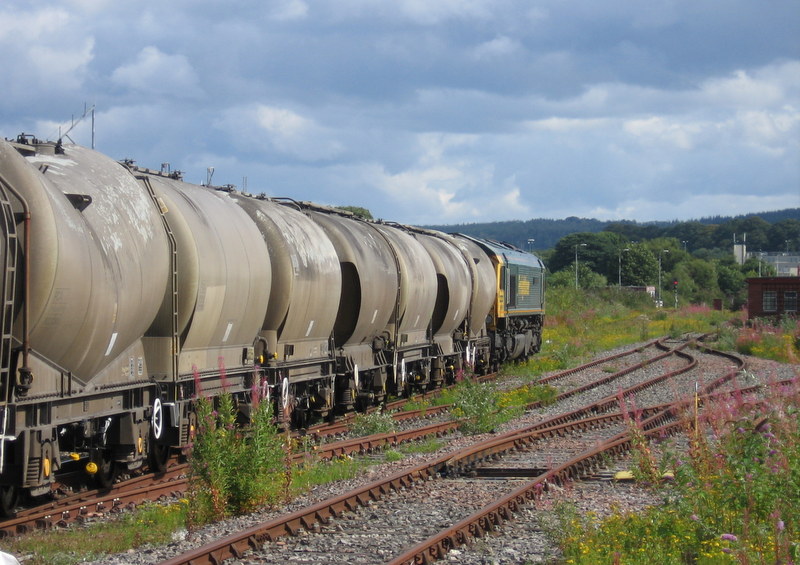The plan to dual the A9 between Perth and Inverness will damage prospects for moving freight from road to rail, according to an expert study for the Scottish Government.
The study, which ministers did not intend to publish, predicts that 80 more lorries a day will travel the A9 in each direction by 2025. At the same time rail freight’s share of the market will drop by a tenth.
Critics say this means that the Scottish Government is likely to fail to meet its target to boost rail freight 7.5 per cent by 2024. Moving heavy goods by train is widely seen as less polluting and safer than by road.
Ministers have agreed a £3 billion programme to upgrade 80 miles of the A9 from single to dual carriageway by 2025. Their agency, Transport Scotland, commissioned the international engineering consultancy, Aecom, to investigate the impact on rail freight between Inverness and Perth.
The investigation was referred to in an official briefing for ministers on 28 September 2016. “It is not the intention to publish the freight study,” the briefing said.
But the 71-page Aecom study, along with the briefing, has now been released under freedom of information law and published by The Ferret. Compiled in 2014 and 2015, it provides a detailed analysis of freight traffic on the A9 and the main highland railway line.
The study pointed out that “rail freight produces 76 per cent less carbon than road freight”. Dualling the A9 was “likely to dampen interest in new companies exploring modal shift from road to rail”, it concluded.
“Realistically the shorter journey times and improved reliability and resilience offered by the A9 dualling are going to lessen the potential switch from road to rail and all other things being equal, are likely to constrain future rail freight growth.”
The study predicted that the average number of lorries using the A9 in each direction every day would rise from 700 to 781 by 2025. Over the same period rail freight’s share of the market would decline from three per cent to 2.7 per cent, it said.
Last year Transport Scotland published its “high level output specification” for railways from 2019 to 2024. “Under this plan the Scottish Ministers would require all reasonable steps to be taken to facilitate growth of 7.5 per cent in rail freight traffic,” it said.
The Rail Freight Group, which represents users and suppliers, reacted with concern. “The imbalanced approach to road and rail investment between Perth and Inverness threatens some existing rail freight flows and severely undermines the scope for rail to win new traffic from the roads,” said the group’s Scottish representative, David Spaven.
“If Scottish Ministers are to deliver targets for rail freight growth – with associated economic, environmental and safety benefits – then they really have to undertake a fundamental reappraisal of Perth-Inverness transport priorities. There should be a level playing field for competition between rail freight and road haulage.”
Colin Howden, director of the campaign group Transform Scotland, accused ministers of “a complete absence of leadership”. The government’s investment strategy for the route to Inverness was “grotesquely biased in favour of road spending,” he said.
“Scottish Ministers seem content to let rail freight continue its decline, and leave rail passengers with a journey time completely uncompetitive with the parallel road route.”
The rail lobby group, Friends of the Far North Line, argued that encouraging freight to move from road to rail ought to be at the forefront of policy to protect the environment.
The group’s convener, Mike Lunan, said: “There is no vestige of even-handedness between the amount being spent on dualling the whole of the A9 south of Inverness, and the amount being spent on doubling modest amounts of the parallel highland main line.”
Transport Scotland described its target to increase rail freight as “challenging but achievable”. The long term aim was to achieve an average journey time of three hours between Inverness and the central belt, with an hourly service and improved opportunities for freight by 2025.
Rail freight offered “a safer, greener, more efficient” way of transporting materials, said a Transport Scotland spokeswoman. “That’s why, since 2007, we’ve invested £9.7 million in 10 freight handling facilities across Scotland, removing over 100 million lorry miles from road.”
There was a planned £5bn investment in Scotland’s railways to 2019, plus a £30m investment fund “helping to better unlock opportunities for rail freight across the country,” she added.
The aim was “to improve the attractiveness of rail freight”, the spokeswoman stated. Network Rail was required “to increase the average speed of freight trains by 10 per cent.”
Freight between Perth and Inverness
| Road | Rail |
|---|---|
| 10m tonnes a year | 300,000 tonnes a year |
| £20bn a year | £500m a year |
| 700 lorries a day in each direction | three trains a day |
| 2.5 hours | 4 hours |
| haul food, drink, retail goods, agricultural supplies, building materials | haul Tesco supplies, cement, nuclear waste, oils, pipes |
The Aecom study in full
Ministerial briefings on rail freight
Photo thanks to David Spaven. A version of this story was published in the Sunday Herald on 24 September 2017.














